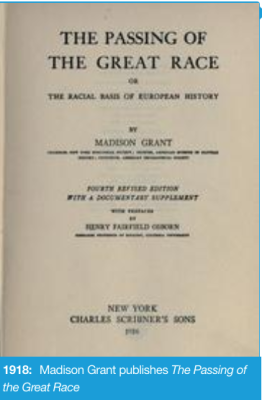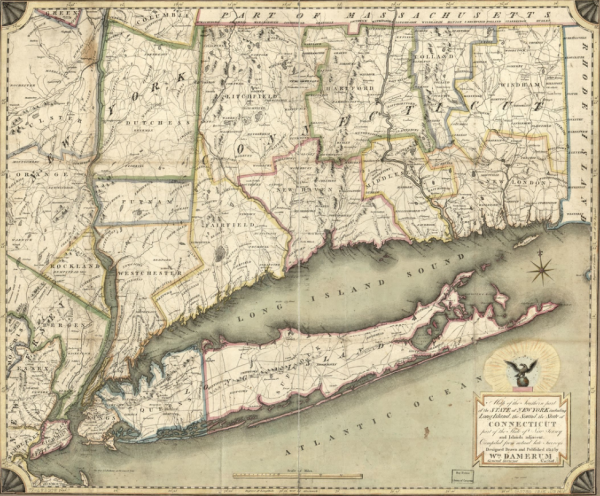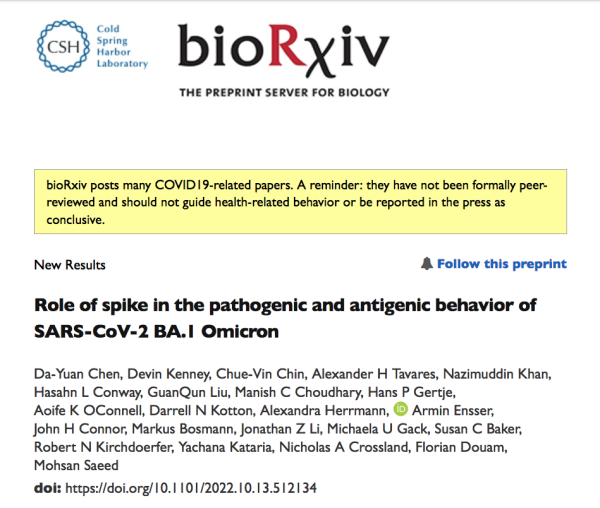Cold Spring Harbor Laboratory
 June 16, 1904. The Carnegie Institution of Washington hosts a gala dedication ceremony on the grounds of the Bio Lab to mark the formal opening of the Station for Experimental Evolution (SEE) at Cold Spring Harbor. The plans for the station had been suggested by eugenicist Charles Davenport, in 1903 (CSHL, 2015). It originally opened for the purposes of studying heredity and evolution, through experiments with plants and animals (CSHL, 2015). The station became a main research centre for American eugenics.
June 16, 1904. The Carnegie Institution of Washington hosts a gala dedication ceremony on the grounds of the Bio Lab to mark the formal opening of the Station for Experimental Evolution (SEE) at Cold Spring Harbor. The plans for the station had been suggested by eugenicist Charles Davenport, in 1903 (CSHL, 2015). It originally opened for the purposes of studying heredity and evolution, through experiments with plants and animals (CSHL, 2015). The station became a main research centre for American eugenics.
The Station was located on 9 acres of land, in Cold Spring Harbor. It was leased for 50 years upon the Station's opening, from the Wawepex Society (CSHL, 2014). Davenport served as director of the station, as well as Cold Spring Harbor Laboratory, and in 1910, the Eugenics Record Office, which would eventually become part of the Department of Genetics (CSHL, 2015).
The Station for Experimental Evolution was eventually renamed the Carnegie Building, and is currently home to the Cold Spring Harbor Laboratory Library & Archives (CSHL, 2015).
Valuable detailed Eugenics Timeline includes policies & laws in USA and Canada. eg 1918. Madison Grant (1865-1937, Yale law degree 1890) was a stalwart of the Nativist/Nordicist (see entry) strain of American eugenics during the progressive-era (~1900-1930). His most renowned work, The Passing of the Great Race: or the Racial Basis of European History (1916), argued for the preservation of America as a ‘civilization preserve’ for the Nordic race, advocating for immigration only from the founding stock of Anglo-Saxons and other Nordics from north-western Europe. The book was highly influential in both Nazi Germany, and North America.1)
Great Gatsby Era History
 To understand the social movements and relationships it is helpful to put them in historic and geographic context. This was the height of Great Gatsby era of opulence and Robber Barons stretched from Manhattan to Newport building palatial estates in the countryside beyond the city.
To understand the social movements and relationships it is helpful to put them in historic and geographic context. This was the height of Great Gatsby era of opulence and Robber Barons stretched from Manhattan to Newport building palatial estates in the countryside beyond the city.
Cold Spring Harbor is nestled among them on Long Island's North Shore Gold Coast under an hour to NYC even then by car train and ferry. OHEKA Castle is one of many mansions converted to public venues but excellent ambiance video. 2)
Connecticut is across LI Sound and less than a mile across in places making a crossing easy for boats or strong swimmers. Port Jefferson Ferries shuttle daily from the Gold Coast to New Haven, home to Yale with its own history of covert influence and questionable science.
The South Fork of LI is “The Hamptons” with Montauk Point the farthest end. There Gurney’s Inn became and remains an elite escape destination flanked by Hither Hills State Park and beach that protects a strip of land from the Atlantic Ocean to the Bay.
Between the forks is Shelter Island notorious for bootleggers, gamblers and gangsters. Beyond the tip of the North Fork's Orient Point is Plum Island Animal Disease Center and BSL4 lab dealing with the most dangerous virus and pathogens. “Since 1954, the DHS S&T Office of National Laboratories (ONL) Plum Island Animal Disease Center (PIADC) has served as the nation's premier defense against accidental or intentional introduction of FADs Foot and Mouth Disease. 3)
There are two ferries that leave from Orient Point, one to New London for the public and separate ferry for cleared personnel to Plum Island. If we sail a little past Plum Island there is Fischer's Island that ranks high in the old money exclusive getaway spots and a nice sail from there to Newport.
Somewhere between Yale, Plum Island and Cold Spring Harbor Lyme disease appeared spread by ticks & deer who swim quite far.
Elite Society Founders Eugenics Archive History
The area of study named was supported by The Long Island Biological Association. Among LIBA's founders and early patrons were such notable American entrepreneurs as Walter Jennings and George Pratt, founders of the Standard Oil Company; J.P. Morgan, the banker; Marshall Field, III, the Chicago storekeeper; William K. Vanderbilt, whose family built a fortune on the Staten Island Ferry and the New York Central Railroad; and Louis Tiffany, whose stained glass creations were already legendary.
Mr. and Mrs. Marshall Field, III (left, in the center) sponsored a gala outdoor circus party in 1932 on their Long Island estate, Caumsett, to benefit the Long Island Association. Guests, each paying $5 for dinner, included George Gershwin and Fred Astaire (right, second from the right).
The membership applied its wealth and enthusiasm with remarkable results, raising $130,000 during LIBA's first five years. Wawepex was renovated as a research laboratory, Davenport Laboratory (now Delbrück) was built in 1926, and 32 acres of land were purchased for expansion.
Photo - Carnegie Station for Experimental Evolution, Cold Spring Harbor, N.Y.
Circa 1915 - The Harry H. Laughlin Papers, Truman State University, Lantern Slides 5)
The Long Island Biological Association
Franklin Hooper, president of the Brooklyn Institute of Arts and Sciences when the Biological Laboratory was founded. James Memorial Laboratory (right) was built of solid concrete to provide a vibration-free environment for exacting biophysics research.
With construction of two winterized facilities, Nichols Memorial Laboratory (1928) and James Memorial Laboratory (1929), year-round research programs in experimental physiology and biophysics were begun. The Laboratory's first full-time investigator, Hugo Fricke, did some of the earliest work on the effect of X-rays on living cells. In 1930, resident endocrinologists drew national attention when adrenal cortical hormone purified at Cold Spring Harbor was used as the first cure for Addison's disease.
Hugo Fricke (left) was the director of biophysics at the Cleveland Clinic Foundation before becoming the Biological Laboratory's first full-time investigator.
The Long Island Biological Association
Harris saw that the rapid influx of ideas from chemistry, physics and mathematics was splintering biology into a number of subdisciplines. Thus, in 1933, he organized the first Cold Spring Harbor Symposium on Quantitative Biology as a means to increase dialogue between the various scientific factions. Sequestered on the tranquil Laboratory grounds, geneticists, biophysicists, biochemists, microbiologists, and physiologists could compare notes on a particular research area undergoing rapid advance.
Participants at the first Symposium on Quantitative Biology in 1933 (above), with organizer Reginald Harris in the foreground. In ensuing years the Symposium was the forum for the first public presentation of both James Watson's and Barbara McClintock's Nobel Prize-winning research.
The merit of Harris' idea was apparent, and the Rockefeller Foundation began long-term support of the Symposium the following year. The Cold Spring Harbor Symposium has continued annually, except for a three-year hiatus during World War II, drawing over the years more than 10,000 participants, including 70 Nobel laureates.
Official Cold Spring Harbor Laboratory
In their own words: “The First Hundred Years a History of Man and Science - The Quantification of Biology”
Historically, biology was based on the direct observation of complex living systems in the natural world and considered a descriptive science intellectually inferior to the hard numbers of physics and chemistry. The formalization of genetics during the first decades of the 20th century marked a departure from the observational tradition and the emergence of biology as a quantitative discipline.
William K. Vanderbilt (above, left) and J.P. Morgan (above, right) were among the wealthy local citizens who founded the Long Island Biological Association in 1924. Vanderbilt also served as a member of the board of directors.
Whereas classical evolutionary theory described macro-order changes that took place over millennia, the experimental evolutionists attempted to induce micro-scale hereditary changes over the course of several generations. Their laboratory experiments were simplified abstractions of the grand sweep of evolution. The use of model systems, where variables could be controlled and external influences minimized, was borrowed directly from the physica1l sciences.
The eugenics movement introduced biology to rigorous mathematical evaluation. In the course of analyzing hereditary data, the influential European eugenicists Francis Galton, a cousin of Charles Darwin, and Karl Pearson developed most of the key statistical measures, including standard deviation, regression, and correlation. Biometry, the application of statistics to biology, became especially important in the emerging field of ecology. 6)
Funding Research
The Carnegie Institution and John D. Rockefeller's Institute for Biomedical Research, founded the same year, were the nation's major sustained sources of support for the basic biological research during the first four decades of the 20th century.
Charles Davenport
For many years Charles B. Davenport was director of all three institutions at Cold Spring Harbor: the Biological Laboratory, the Carnegie Department of Experimental Evolution, and the Eugenics Record Office.
Cold Spring Harbor became a summer camp for science. Courses on zoology, bacteriology, botany, comparative anatomy, microscopic methods, and nature study gave biology teachers hands-on training that was generally lacking from their college preparation.
In 1898, Charles Davenport, a professor of the evolutionary biology at Harvard University, became director of the Biological Laboratory. Over the next several years, he introduced a series of course that investigated “the normal variation of animals in the harbor, lakes, and woods, and the production of abnormalities,” and a course in ecology.
Between 1890 and 1910, more than 2,000 high school and college teachers came to Cold Spring Harbor to learn what could not be learned from textbooks alone.
CSH War on Cancer
On December 23, 1971, President Richard M. Nixon signed the National Cancer Act, authorizing the most massively-funded civilian war in history. It was the culmination of the growth of federal sponsorship of medical research that began with the wartime OSRD. Over the ensuing 10 years, $7.5 billion in support, funneled through the National Cancer Institute, stimulated an unprecedented expansion in basic biological research. The increased funding fell on a biological research community enormously excited by its new understanding of the role of DNA in directing the machinery of life.
By the late 1960s, the confluence of molecular genetics, virology, and animal cell culture was revolutionizing the study of biochemistry of higher cells. Sophisticated methods had been developed to grow mammalian and human cell lines in culture dishes in the manner of bacteria. It had also been demonstrated that certain animal viruses, known as tumor viruses, can “transform” cultured cells into cancerous equivalents. It was thus possible to mimic cancer in a petri dish and to perform controlled experiments on the origin and progression of malignancy.
A Cold Spring Harbor course taught each summer since 1958 was instrumental in introducing researchers to the new techniques for culturing animal cells and their viruses. The potential power of the tumor virus model system prompted a migration of former phage biologists into the field of basic cancer research. Bacteriophages had provided a means to probe the genetics of bacterial cells; now the tumor viruses made possible a similar approach to mammalian cells. 7)
Experimental Evolution and Genetics Research
Although the staff of the Carnegie Institution’s Station for Experimental Evolution was small at first, important early work was performed both in and around the Main Building. Immediately after receiving his Ph.D. from the University of Chicago in 1906 George Shull (1874–1954) came to Cold Spring Harbor and began planting maize (Indian corn) in an experimental garden on the east side of the Main Building.
By 1908 he was reporting in the Carnegie Institution of Washington Yearbook experiments that became world-famous. Shull showed that when two different but carefully inbred strains of corn were crossed, the yield was 20% higher than if each strain were allowed to self-pollinate. This phenomenon of “hybrid vigor” that he demonstrated experimentally was later employed in commercial seed production to create high-yielding strains that today make corn the most important agricultural crop in the United States.
Also in 1908, in the basement of the Main Building, Charles Banta conducted cave experiments aimed at inducing color mutations in tadpoles of the tiger salamander.
In 1914, the Animal House (now McClintock Laboratory) was completed and the animal breeding experiments at Cold Spring Harbor were moved from the Main Building to this new facility.
In 1923, Cornell-trained biogeneticist Milislav Demerec (1895-1966) was appointed to the Carnegie Department of Genetics by assistant director Albert Blakeslee (1874–1954). Although trained as a maize geneticist, Demerec soon turned his efforts at Cold Spring Harbor to the fruit fly Drosophila.
His work was done on the second floor of the Main Building. In the late 1930s Demerec and Calvin Bridges, who was at the California Institute of Technology, collaborated during the summers on drawing large-scale maps of the four Drosophila chromosomes, which was considered quite a feat in those days. By 1940 the first edition of Demerec’s Drosophila Guide appeared. This classic in its field was destined to go through eight editions, the last appearing in 1969.
Barbara McClintock was a member of the Carnegie staff and the cornfields where she found evidence of movable genetic switches—“jumping genes”—that can turn genes on and off were next to the Main Building.
As early as 1946 it had become apparent that a major new building would be required if the genetics program at Cold Spring Harbor were to have a future in a scientific world in which molecules as well as chromosomes were investigated. The 1905 Main Building and the 1914 Animal House were inadequate for the kinds of research they now wished to do.
In 1953 the Demerec Laboratory was completed and the Main Building officially became the Carnegie Library. In addition to housing laboratories, the Main Building had long served as the main repository of reference works and journals for both the Carnegie Department of Genetics and the Bio Lab, and this was now its sole function. 8)
Viral Eugenics
 Role of spike in the pathogenic and antigenic behavior of SARS-CoV-2 BA.1 Omicron
Role of spike in the pathogenic and antigenic behavior of SARS-CoV-2 BA.1 Omicron
Da-Yuan Chen, Devin Kenney, Chue-Vin Chin, Alexander H Tavares, Nazimuddin Khan, Hasahn L Conway, GuanQun Liu, Manish C Choudhary, Hans P Gertje, Aoife K OConnell, Darrell N Kotton, Alexandra Herrmann, View ORCID ProfileArmin Ensser, John H Connor, Markus Bosmann, Jonathan Z Li, Michaela U Gack, Susan C Baker, Robert N Kirchdoerfer, Yachana Kataria, Nicholas A Crossland, Florian Douam, Mohsan Saeed doi: https://doi.org/10.1101/2022.10.13.512134 This article is a preprint and has not been certified by peer review
Abstract
The recently identified, globally predominant SARS-CoV-2 Omicron variant (BA.1) is highly transmissible, even in fully vaccinated individuals, and causes attenuated disease compared with other major viral variants recognized to date. The Omicron spike (S) protein, with an unusually large number of mutations, is considered the major driver of these phenotypes. We generated chimeric recombinant SARS-CoV-2 encoding the S gene of Omicron in the backbone of an ancestral SARS-CoV-2 isolate and compared this virus with the naturally circulating Omicron variant. The Omicron S-bearing virus robustly escapes vaccine-induced humoral immunity, mainly due to mutations in the receptor binding motif (RBM), yet unlike naturally occurring Omicron, efficiently replicates in cell lines and primary-like distal lung cells. In K18-hACE2 mice, while Omicron causes mild, non-fatal infection, the Omicron S-carrying virus inflicts severe disease with a mortality rate of 80%. This indicates that while the vaccine escape of Omicron is defined by mutations in S, major determinants of viral pathogenicity reside outside of S. Competing Interest Statement
The authors have declared no competing interest. 9)
Virus Promoters, DNA Clones and GMO Rice
Discovery of a novel merbecovirus DNA clone contaminating agricultural rice sequencing datasets from Wuhan, China
HKU4-related coronaviruses are a group of betacoronaviruses belonging to the same merbecovirus subgenus as Middle Eastern Respiratory Syndrome coronavirus (MERS-CoV), which causes severe respiratory illness in humans with a mortality rate of over 30%.
The high genetic similarity between HKU4-related coronaviruses and MERS-CoV makes them an attractive subject of research for modeling potential zoonotic spillover scenarios. In this study, we identify a novel coronavirus contaminating agricultural rice RNA sequencing datasets from Wuhan, China.
The datasets were generated by the Huazhong Agricultural University in early 2020. We were able to assemble the complete viral genome sequence, which revealed that it is a novel HKU4-related merbecovirus.
The assembled genome is 98.38% identical to the closest known full genome sequence, Tylonycteris pachypus bat isolate BtTp-GX2012. Using in silico modeling, we identified that the novel HKU4-related coronavirus spike protein likely binds to human dipeptidyl peptidase 4 (DPP4), the receptor used by MERS-CoV. We further identified that the novel HKU4-related coronavirus genome has been inserted into a bacterial artificial chromosome in a format consistent with previously published coronavirus infectious clones.
Additionally, we have found a near complete read coverage of the spike gene of the MERS-CoV reference strain HCoV-EMC/2012, and identify the likely presence of a HKU4-related-MERS chimera in the datasets.
Our findings contribute to the knowledge of HKU4-related coronaviruses and document the use of a previously unpublished HKU4 reverse genetics system in apparent MERS-CoV related gain-of-function research. Our study also emphasizes the importance of improved biosafety protocols in sequencing centers and coronavirus research facilities.
Competing Interest Statement
The authors have declared no competing interest.
Paper in collection COVID-19 SARS-CoV-2 preprints from medRxiv and bioRxiv 10)


